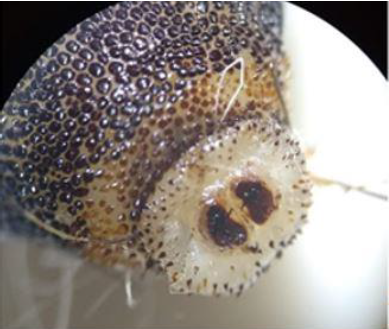Cutaneous myiasis by Cuterebra spp. in an antelope hare (Lepus alleni) from Hermosillo, Sonora, Mexico
Keywords:
Cuterebra spp, Sonora, antelope hare, myasisAbstract
This work aimed to report the first case of Cuterebra spp. in an antelope hare in Hermosillo, Sonora, Mexico. A morphological analysis of the larvae was carried out, where the tissue densely covered with squamiform spines and spicules with twisting labyrinths was associated with Cuterebra spp. Microscopic lesions showed granulation tissues, dermoid cysts and spicules, and fibrous connective tissue delimiting the parasite, where the structures observed are the cuticle and spicules of the parasite, causing a mononuclear inflammatory reaction at the subcutaneous level. Although this genus is widely distributed in the country, there is no documented information on this myiasis in Sonora. The host was found close to an urbanization area, representing a risk to the human population.
e2021-76
References
AZKARATE JC, Coldwell DD, Kenny D, Solórzano B, Shedden A, Cassaigne I, Luna ER. 2012. First report of bot fly (Cuterebra baeri) infestation in howler monkeys (Aloutta palliata) from Mexico. Journal of Wildlife Diseases. 48(3):822–825.
https://doi.org/10.7589/0090-3558-48.3.822
BERMÚDEZ SE, González P, Ávila M, Miranda R, Armién A, Armién B. 2010. Parasitism of Cuterebra spp. (Diptera: Oestridae s.l.) on rodents of Central Panama. Revista Mexicana de Biodiversidad. 81: 57‒60.
http://www.scielo.org.mx/pdf/rmbiodiv/v81n1/v81n1a9.pdf
BEST TL, Henry TH. 1993. Lepus alleni. Mammalian species. 424:1‒8.
https://doi.org/10.2307/3504245
BOWMAN DD. 2011. Georgis: Parasitología para Veterinarios. 9a ed. Elsevier Barcelona, España. Pp. 31-32. ISBN 978-84-8086-705-4
CORNET M, Floret M, Lefebvre A, Wertheimer C, Perez-Eid C, Bangs MJ, Bouvet A. 2003. Tracheopulmonary myiasis caused by a mature third-instard Cuterebra larva: Case report and review. Journal of clinical microbiology. 41 (12): 5810-5812. https://doi.org/10.1128/JCM.41.12.5810-5812.2003
CRUZ DL, Rodrigues FF, Linhares AX. 2009. Prevalence of larvae of the bot fly Cuterebra simulans (Diptera, Oestridae) on Gracilinanus microtarsus (Didelphimorphia, didelphidae) in southeastern Cerrado from Brazil. Revista Brasileira de Entomología. 53
(2): 314‒317. https://doi.org/10.1590/S0085-56262009000200017
FRANCESCONI F, Lupi O. 2012. Myiasis. Clinical Microbiology Reviews. 25:79‒105.
https://doi.org/10.1128/CMR.00010-11
GRZYB MJ, Belliveau MJ, Kratky V. 2011. Persistent eyelied swelling in a child caused by Cuterebra myiasis. Canadian journal of ophthalmology. 46 (6): 553-554. https://doi.org/10.1016/j.jcjo.2011.09.020
HELM TN, Augenblick K, Gall W. 2010. Furuncular Myiasis: A Case Report. Cutis. 86: 85-86.
https://cdn.mdedge.com/files/s3fs-public/Document/September-2017/086020085.pdf
LARA LN, Jaume SS, Ibañez BS. 2017. An incidental case of gastric pseudomyiasis in Canis latrans (Carnivora: Canidae) by a rabbit bot fly Cuterebra spp. (Diptera: Oestridae). Revista Mexicana de Biodiversidad. 88:410‒414.
PAPE T. 2001. Phylogenetic of Ostrediae (insecta: Diptera). Systematic Entomology. 26:133‒171. https://doi.org/10.1046/j.1365-3113.2001.00143.x
SCHLESENER BN, Peck EA, Teplitz EM, Espinheira GF, Bowman DD, Lucio-Foster A, Ledbetter EC. 2021. Feline opthalmomyasis externa caused by Cuterebra larvae: four cases (2005-2020). Journal of feline medicine and surgery. 1-9.
https://doi.org/10.1177/1098612X211013021
ZÚÑIGA CIR. 2009. Miasis: un problema de salud poco estudiado en México. Revista de enfermedades infecciosas en pediatría. 22(88). https://www.medigraphic.com/pdfs/revenfinfped/eip-2009/eip092f.pdf



